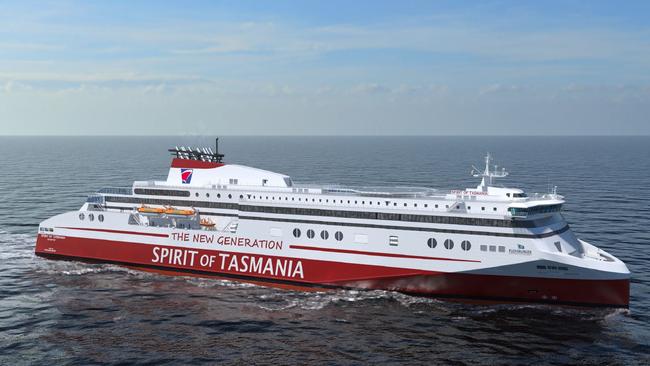Rex Gardner: Sailing into the future with our new-look Spirits
THE new Spirit of Tasmania ferries, worth about $460 million each, will be “floating hotels”— a far cry from the vessels that have plied Bass Strait over the years.

Opinion
Don't miss out on the headlines from Opinion. Followed categories will be added to My News.
THE new Spirit of Tasmania ferries, worth about $460 million each, will be “floating hotels”— a far cry from the vessels that have plied Bass Strait over the years.
The new Spirits will take the crossing of one of the world’s nastiest stretches of water to a new level of comfort and present tourists with just about the best ferry experiences available.
The recent unveiling of the proposal to build two new Spirits at the German Flensburger Schiffbau-Gesellschaft (FSG) shipyards in the Baltic port of Flensburg two years ahead of schedule came just in time for the state election build-up.
The new eco-friendly Spirits, with dual-fuel engines running on gas and low-sulphur diesel, will be crossing Bass Strait from 2021 — the first in May and the second from November.
Just in time for the next state election!
When you step aboard, the new ships will be bigger in every way from the current Spirits.
Technology will be cutting-edge and the look and feel and colour will be inspired by Tasmanian experiences, from timber panelling, to imagery to art and sculptures.
The entire seventh level of the new ships — from stern to bow — will be all public space, which will be up almost 50 per cent on the current Spirits.
There’ll be lounges, bars, dining areas and movie theatres. You might walk into a Tasmanian whisky bar, or a bar serving Tasmanian gins.
Up forward, level seven will have panoramic views out over the bow to Bass Strait, something that is blocked out these days. That could make for an exciting night at the bar as the ship ploughs into 6m swells.
There will be more retail outlets and shopfronts for Tasmanian tourist operators, entertainment areas for families, quiet nooks for reading and relaxing, and maybe even fitness areas.
Let’s say the Porsche Club of Victoria comes aboard with 100 vehicles and 200 members in readiness for a two-week tour of Tasmania. One of the bars on level seven could be hired out and rebadged Porsche Bar for the night.
All this is still in the melting pot, but the TT-Line is big on grilling its customer base about what it wants from a brief sea voyage, and for the first time in the history of Tasmania’s Bass Strait ferries, the company has the chance to design purpose-built ships from the keel up.
But underneath all the new, hi-tech levels of passenger comfort, there’s a lot more going on for additional freight capacity.
This may be a yawn for passengers out for a good time at sea, but because of the new Spirits’ huge expansion of freight space, future growth for Tasmanian producers into mainland markets for the agriculture and aquaculture sectors is now assured.
Harvest your vegies in the paddock today and they can be on sale at Victoria Market tomorrow.
The agriculture sector in Tasmania is quietly celebrating big time, but more about that later.
Tasmania’s ferries over the past 100 years have always been ships re-purposed and converted in some shape or form for the Bass Strait run.
TT-Line CEO Bernard Dwyer said while internal specifications for layout and design of the FSG ships had not been finalised, the company’s vision was to offer increased comfort and enjoyment and experiences for passengers.
The entire ship will be hi-tech, offering the latest in communication and entertainment, he said.
“In 2021 our market will be Millennials. What will they want?” Mr Dwyer said.
“We’ll have to be offering at least what they have at home, for starters.
“We expect everything will be wireless, and our challenge will be to find things that are unique. Today it could be virtual reality experiences, in 2021 it could be totally different but we have design a ship to be ready for it.”
The Spirits will have at least 60 more cabins, all with hi-tech facilities.
There will be more deluxe cabins, with more floor space, bigger beds and bigger bathrooms.
Recliner lounges will be extended by 60 per cent, with a business-class section for those willing to pay for comfort.
Business-class seats will have personal screens, movies on demand and all the trimmings.
The ships will take 2000 passengers (up 40 per cent) and 70 per cent more cars.
There will be three levels of vehicle access to the docks in Devonport and Melbourne’s Station Pier, which will need new infrastructure.
But because of the extra levels, ship turnaround times — embarkation and disembarkation — will be reduced, possibly to under two hours.
Tasmania’s tourism growth in recent years has resulted in TT-Line’s numbers going through the roof.
Currently, 435,000 passengers a year come by sea to Tasmania, up 31 per cent in the past four years. TT-Line’s predictions in the business plan are a modest 625,000 passengers by 2035. That could be easily eclipsed.
While passenger comfort is paramount for TT-Line, and the knowledge that sea visitors spend $2900 a head compared to those arriving by aircraft $1600, it is additional freight that has the agricultural and aquaculture sectors jumping.
Mr Dwyer said at the moment, TT-Line is having trouble keeping up with demand
“The biggest factor is capacity, and with the new, bigger ships we will be able to soak up a lot of our day sailings on the night runs,” he said.
“The substantial extra freight capacity ties in with the future growth of Tasmania. And this will take the artificial choke off all of those business — agriculture, aquaculture, manufacturing — which need to move product into markets.
“It will have a huge impact on agriculture. It will provide much more employment for the north west coast.”
Mr Dwyer said TT-Line was proud the new vessels would be funded entirely out of company reserves, and not from state money. The only state contribution was $20 million for a vessel replacement fund, but the rest would come from paying customers.
Rex Gardner is a former chief executive of the Mercury.


